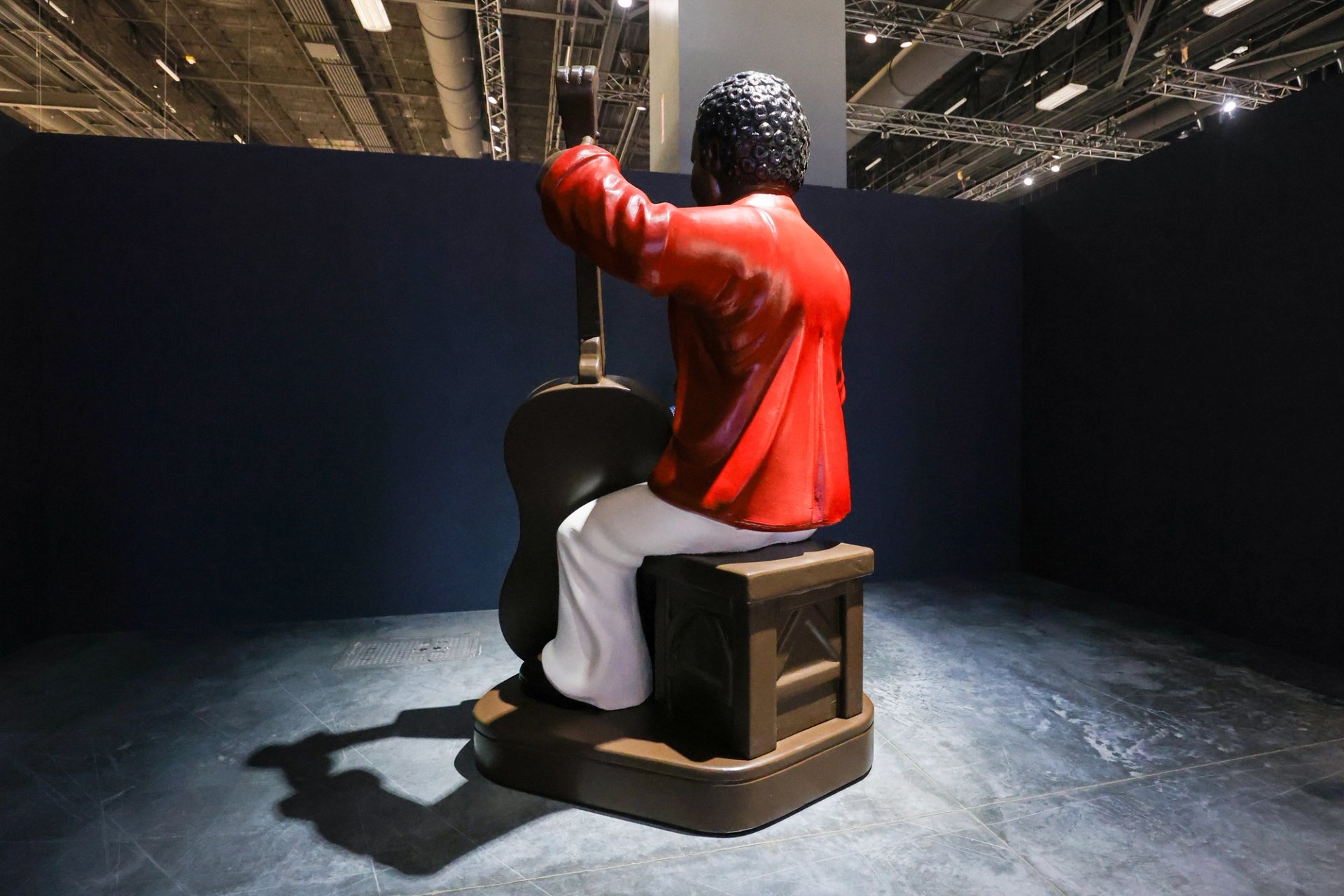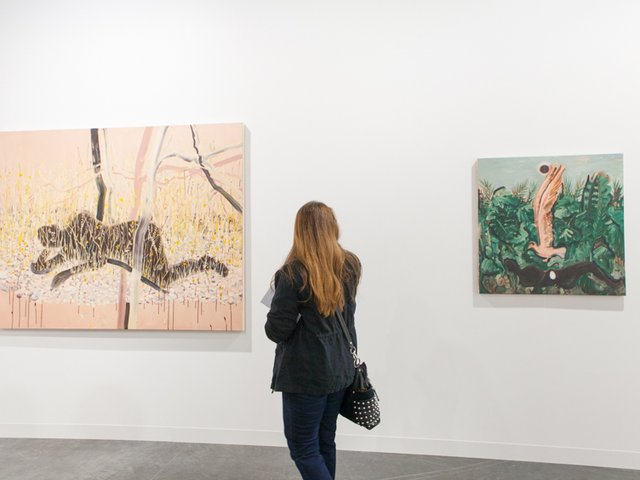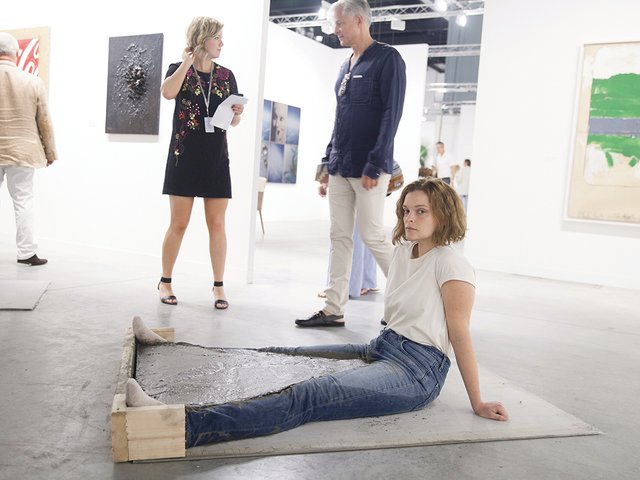Should art engage with politics or offer an escape from politics? This is the question dealers, artists and collectors have tended to face in the run-up to Art Basel in Miami Beach from its very first outing. (It is worth remembering that the event’s inaugural edition, originally planned for 2001, was postponed for a year due to the 11 September terror attacks.)
The dilemma has been particularly stark this autumn, as the bloody conflict between Israel and Hamas has intensified the culture wars that once again increasingly define US electoral politics amid a 2024 presidential campaign that is in full swing. But surveying the 2023 edition of Art Basel in Miami Beach, and Miami Art Week more broadly, has left many participants with the distinct impression that the art trade has shrunk from the moment.
It does not surprise me that dealers would opt to stay far away from politics, considering how high the stakes are to make a statement about the Israel-Hamas warLisa Austin, art adviser
“This year the fair seems to be a bubble outside of political events,” says Lisa Austin, the Miami-based adviser of Art Basel. “It does not surprise me that dealers would opt to stay far away from politics, considering how high the stakes are to make a statement about the Israel-Hamas war. I went to a gallery dinner last night where the discussion was much more open, and there was a question about whether people had decided not to come because of it.”
Neutral aisles
Unlike during the years of Donald Trump’s presidency, there are few works installed in the 277 stands of Art Basel’s latest edition that seem eager to tangle with the hot-button issues of the moment. Those that come closest tend to communicate existential distress over the state of politics and culture, almost assuredly a safer approach when money is on the line.
For instance, Alfredo Jaar’s He Ram (1991), being offered by Goodman Gallery, transcribes the Seven Social Sins defined by Mahatma Gandhi—including “politics without principle” and, more pointedly here, “commerce without morality”—on a nearly 2.5 sq. m mirror on an exterior wall of the gallery’s stand.
Another, more modestly sized example also comes from Jaar. The 2018 photograph A Logo for America (Miami Beach), prominently installed on an exterior wall of Galerie Lelong’s stand, combines six sequential images of an electronic billboard display challenging the conflation of “America” with the US, to the exclusion of the rest of the continents, installed by the Chilean artist on a barge off the coast of Miami Beach during the 2018 Faena Festival.
Mary Sabbatino, the vice president and a partner at Galerie Lelong, calls the piece “a perfect fit for the fair, as it places one of Jaar’s most notable interventions within the context of Miami’s arts and culture scene”. Priced at $50,000 to $100,000, the work is an edition of three, with one edition still available as of Friday morning.
The gallery feels it is “important that we present exceptional examples of our artists’ work” at fairs, which provide the opportunity to connect with a broad range of collectors, curators and advisers, not all of whom may be familiar with a given artist’s practice. Sabbatino adds: “For an artist such as Alfredo Jaar, who devotes his practice to examining complex sociopolitical issues and the limits and ethics of representation, showing a work such as A Logo for America (Miami Beach) that encapsulates this core component of his practice is necessary.”
At least a few more politically engaged works have penetrated the fair—they just require more effort on the part of visitors to decode. US performance artist Karen Finley’s installation Go Figure, on Freight+Volume’s stand, comprises a life-drawing class that was due to go on show at the Whitney Museum of American Art in New York in 1998. Finley was one of four artists who sued the National Endowment for the Arts (NEA) for withdrawing grants on the grounds of indecency amid the culture wars of that decade. The group lost its challenge, with the US Supreme Court subsequently upholding the decision in 1998; the Whitney then cancelled Finley’s exhibition, citing budget constraints.
Precarious as it can be for dealers to present works with an overtly partisan viewpoint in any section of a fair, art advisers must tiptoe along a similarly thin line. But there is an argument that if they take such caution now, their clients’ collections could benefit over time.
I feel that political work can be most effective if it is less tied to a definitive event, if it has some universality rather than specificityLiz Parks, art adviser
“I feel that political work can be most effective if it is less tied to a definitive event, if it has some universality rather than specificity, so that 30 years later it conjures a timeless human emotion as opposed to a singular moment in time,” says the New York-based art adviser Liz Parks. “There is so much polarisation out there, and, seemingly, so little openness to taking the time to understand complex issues, to nuance. I’d rather go the long game with nuance, and I suppose this is how I am guiding my clients.”
The Meridians exception
In contrast to the gallery stands, the fair’s Meridians section is home to multiple works confronting the culture wars head-on. Prime among these is the Minnesota-based Indigenous artist Julie Buffalohead’s Our Bodies Our Choice (2023), presented by Jessica Silverman.
Buffalohead, a member of the Ponca tribe of Oklahoma, says her expansive diptych “pays homage to the Haudenosaunee (Iroquois) creation myth of the Sky Woman”, a pregnant woman who tumbled through a hole in the heavens to the world below, inspiring various animals to break her fall and begin building the land on which she and her child could thrive. (The folklore of other tribes in the Great Lakes region also includes variants of the Sky Woman legend.)
Still, it is nearly impossible to view the work, let alone consider its title, without making the connection to the US Supreme Court’s 2022 decision to overturn Roe v. Wade, which had federally safeguarded a woman’s right to terminate a pregnancy since 1973. Reproductive choice is a particularly acute issue in Florida, where governor (and flailing presidential hopeful) Ron DeSantis and a right-wing state legislature have outlawed abortion after 15 weeks of pregnancy.
Yet Buffalohead says the work’s resonance in this site goes beyond Roe: “Native American women were indigenous to Florida long before it was a state. Historically, so many laws have attempted to regulate and restrict people, traditions and practices [that] have inhabited Florida. So when do the regulations go too far?” She adds that “it is a cultural practice amongst Native people to be in charge of their choices”, making the current political climate in the US a continuation of longstanding injustices.
Other Meridians works intensify the political charge. The Argentine artist Marcelo Brodsky’s 1968: The Fire of Ideas (2014-18) combines photographs, drawings and inscriptions charting multiple revolutions in thought and action across the world during the titular era. Reginald O’Neal’s The Cellist (2023), a towering figure of a Black cellist positioned with his back to passersby, comments on the US’s longstanding exclusion and exploitation of talented people of African heritage.

Reginald O’Neal’s The Cellist was bought by Jorge Pérez’s institution El Espacio 23 Photo: Liliana Mora
It makes sense for the Meridians section to harbour more works that speak out than the rest of Art Basel in Miami Beach. The oversized dimensions of the paintings, sculptures and installations on show in the section naturally limit their commercial prospects to collecting institutions and high net worth individuals with either their own private museums or properties of institutional scale. Placing works with a museum generally requires extended discussions more conducive to working through complex issues.
But private collectors sympathetic to a gargantuan work’s political position do exist—and they can move quickly. O’Neal’s The Cellist, presented by the Miami-based gallery Spinello Projects, was acquired by El Espacio 23, the private institution founded by the collector and property developer Jorge M. Pérez for an undisclosed price on Thursday. It may be a rare transaction, but it also proves that sometimes, playing it safe is not rewarded, even at a premier art fair.




